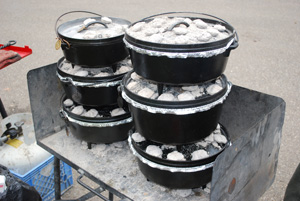
 As settlers traveled across the country a couple hundred years ago, their needs were simple even though times were harsh. Food, shelter and safety were primary. After trudging laborious miles through strange lands, scared, exhausted and many sick, a rewarding meal was often looked forward to at day's end. This made one piece of gear more of a treasure than a travel accessory: the cast iron kettle, or Dutch oven. Today, a Dutch oven is a treasure found around campfires as a luxury more so than a necessity.
As settlers traveled across the country a couple hundred years ago, their needs were simple even though times were harsh. Food, shelter and safety were primary. After trudging laborious miles through strange lands, scared, exhausted and many sick, a rewarding meal was often looked forward to at day's end. This made one piece of gear more of a treasure than a travel accessory: the cast iron kettle, or Dutch oven. Today, a Dutch oven is a treasure found around campfires as a luxury more so than a necessity.
Pulling a Dutch oven from the vehicle or RV at a campground usually draws comments from neighboring campers. Conversations covering recipes, Dutch oven cooking techniques and personal tricks learned from using cast iron cookery, stir excitement for the next camp meal.
Since the Dutch oven made the trip over the Atlantic aboard ships transiting people looking for new, better lives, the cast iron kettle has remained a diverse cooking device known to those people and their descendants. The previously, legless bottomed kettle soon was reshaped to accommodate their important work. With three short legs added to the design, Americans found it easier to control the temperature for a wide range of cooking and baking needs. From soups to thick stews, and from breads to cakes and pies, the simple Dutch oven provided the tool to deliver an evenly planned meal — and still does today.
The biggest challenge, but shouldn't be, for new Dutch oven cooks is maintaining the correct cooking temperature. This is simply done via charcoal briquettes, that is, with a specific number of them per size of oven used. Although merely placing an oven over an open fire will do for some recipes, for an accurate cooking temperature, charcoal is ideal.
Oven manufacturers include a guide or chart instructing how many lit charcoal briquettes should be placed underneath the Dutch oven and how many on top of the lid is needed to produce and maintain the recipe's desired temperature. As a rule, one-third of the total briquettes go on top and the remaining two-thirds underneath. For example: using a 12-inch Dutch oven, placing 16 briquettes under the oven and eight on the lid will generate 350 degrees for about an hour. Pretty simple for any grade of cook to handle, but the result will taste anything but ordinary.
Other than a pair of welder's gloves, or similar pair of heavily insulated leather gloves, and a metal lid lifter, pair of metal tongs (for handling charcoal briquettes), and a sturdy but packable tripod, there is nothing more needed to create delicious meals — except for heat source of course. A Dutch oven may not be the necessity it was centuries ago, but the food prepared in the cast iron cooker will be just appreciated nearly as much at camp.
- 3856 views

